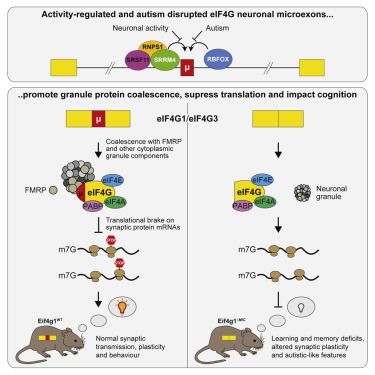Our official English website, www.x-mol.net, welcomes your
feedback! (Note: you will need to create a separate account there.)
Autism-Misregulated eIF4G Microexons Control Synaptic Translation and Higher Order Cognitive Functions.
Molecular Cell ( IF 14.5 ) Pub Date : 2020-01-25 , DOI: 10.1016/j.molcel.2020.01.006 Thomas Gonatopoulos-Pournatzis 1 , Rieko Niibori 2 , Eric W Salter 3 , Robert J Weatheritt 4 , Brian Tsang 5 , Shaghayegh Farhangmehr 6 , Xinyi Liang 7 , Ulrich Braunschweig 1 , Jonathan Roth 8 , Shen Zhang 2 , Tyler Henderson 9 , Eesha Sharma 6 , Mathieu Quesnel-Vallières 6 , Jon Permanyer 10 , Stefan Maier 2 , John Georgiou 2 , Manuel Irimia 11 , Nahum Sonenberg 12 , Julie D Forman-Kay 5 , Anne-Claude Gingras 9 , Graham L Collingridge 13 , Melanie A Woodin 7 , Sabine P Cordes 9 , Benjamin J Blencowe 6
Molecular Cell ( IF 14.5 ) Pub Date : 2020-01-25 , DOI: 10.1016/j.molcel.2020.01.006 Thomas Gonatopoulos-Pournatzis 1 , Rieko Niibori 2 , Eric W Salter 3 , Robert J Weatheritt 4 , Brian Tsang 5 , Shaghayegh Farhangmehr 6 , Xinyi Liang 7 , Ulrich Braunschweig 1 , Jonathan Roth 8 , Shen Zhang 2 , Tyler Henderson 9 , Eesha Sharma 6 , Mathieu Quesnel-Vallières 6 , Jon Permanyer 10 , Stefan Maier 2 , John Georgiou 2 , Manuel Irimia 11 , Nahum Sonenberg 12 , Julie D Forman-Kay 5 , Anne-Claude Gingras 9 , Graham L Collingridge 13 , Melanie A Woodin 7 , Sabine P Cordes 9 , Benjamin J Blencowe 6
Affiliation

|
Microexons represent the most highly conserved class of alternative splicing, yet their functions are poorly understood. Here, we focus on closely related neuronal microexons overlapping prion-like domains in the translation initiation factors, eIF4G1 and eIF4G3, the splicing of which is activity dependent and frequently disrupted in autism. CRISPR-Cas9 deletion of these microexons selectively upregulates synaptic proteins that control neuronal activity and plasticity and further triggers a gene expression program mirroring that of activated neurons. Mice lacking the Eif4g1 microexon display social behavior, learning, and memory deficits, accompanied by altered hippocampal synaptic plasticity. We provide evidence that the eIF4G microexons function as a translational brake by causing ribosome stalling, through their propensity to promote the coalescence of cytoplasmic granule components associated with translation repression, including the fragile X mental retardation protein FMRP. The results thus reveal an autism-disrupted mechanism by which alternative splicing specializes neuronal translation to control higher order cognitive functioning.
中文翻译:

自闭症失控的eIF4G微外显子控制突触翻译和高阶认知功能。
Microexon代表了最高度保守的替代剪接类,但对其功能的了解却很少。在这里,我们专注于紧密相关的神经元微外显子,在翻译起始因子eIF4G1和eIF4G3中重叠病毒样结构域,其剪接是活动依赖性的,并且在自闭症中经常受到干扰。这些微外显子的CRISPR-Cas9缺失选择性地上调了控制神经元活动和可塑性的突触蛋白,并进一步触发了与活化神经元相似的基因表达程序。缺乏Eif4g1 microexon的小鼠表现出社交行为,学习和记忆缺陷,并伴有海马突触可塑性改变。我们提供的证据表明,eIF4G微外显子通过引起核糖体失速而起翻译制动器的作用,通过它们促进与翻译抑制相关的细胞质颗粒成分(包括脆弱的X智力障碍蛋白FMRP)的融合。结果因此揭示了一种自闭症破坏机制,通过该机制,选择性剪接使神经元翻译专门控制高阶认知功能。
更新日期:2020-01-29
中文翻译:

自闭症失控的eIF4G微外显子控制突触翻译和高阶认知功能。
Microexon代表了最高度保守的替代剪接类,但对其功能的了解却很少。在这里,我们专注于紧密相关的神经元微外显子,在翻译起始因子eIF4G1和eIF4G3中重叠病毒样结构域,其剪接是活动依赖性的,并且在自闭症中经常受到干扰。这些微外显子的CRISPR-Cas9缺失选择性地上调了控制神经元活动和可塑性的突触蛋白,并进一步触发了与活化神经元相似的基因表达程序。缺乏Eif4g1 microexon的小鼠表现出社交行为,学习和记忆缺陷,并伴有海马突触可塑性改变。我们提供的证据表明,eIF4G微外显子通过引起核糖体失速而起翻译制动器的作用,通过它们促进与翻译抑制相关的细胞质颗粒成分(包括脆弱的X智力障碍蛋白FMRP)的融合。结果因此揭示了一种自闭症破坏机制,通过该机制,选择性剪接使神经元翻译专门控制高阶认知功能。











































 京公网安备 11010802027423号
京公网安备 11010802027423号